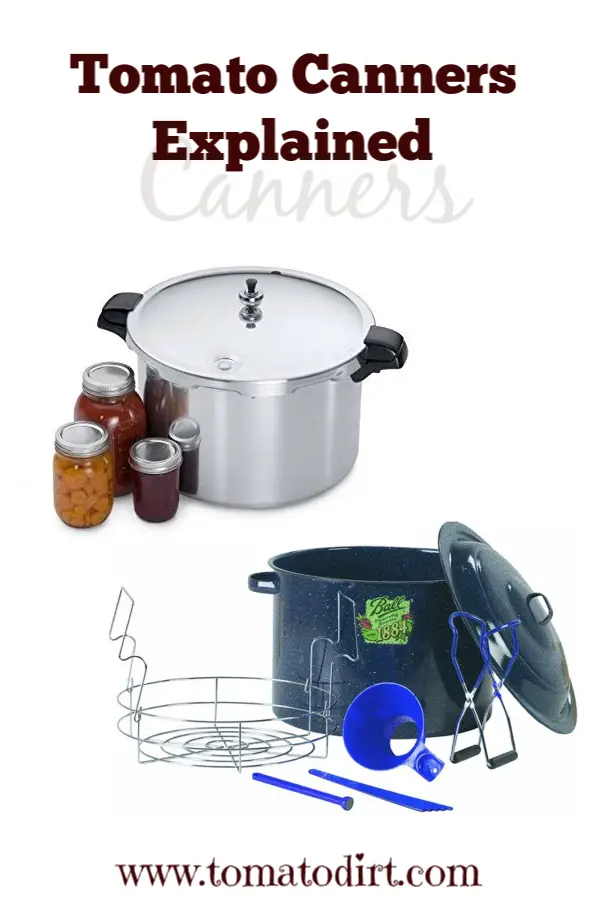FREE: 10 Must-Know Tomato Growing Tips Get The Guide
Read our affiliate disclosure here.
Tomato Canners: Should You Use a Pressure Canner or Hot Water Bath?
Since 2010, Tomato Dirt has garnered 4.8+ million views, making it the web’s leading online source for growing tomatoes in the home garden. Award-winning writer and Tomato Dirt owner Kathy Widenhouse has helped thousands of home gardeners grow healthier tomatoes. Be one of them when you get Tomato Dirt’s Growing Guide here.
Updated 8.5.24
There are two types of tomato canners most commonly used in processing tomatoes from the home garden: pressure cannerA Tale of Two Tomato Canners
Here’s a brief description of both tomato canners and how they work.Pressure canner. A pressure canner
Water bath canner. A hot water bath canner
One Note about Canning Tomatoes
Tomatoes face two potential dangers when canned at home: bacteria, specifically Clostridium botulinum (which can live in improperly preserved foods and causes botulism) and other molds, yeasts, and enzymes which can cause tomatoes to decompose and lose flavor.
Clostridium botulinum bacteria do not flourish in high acid foods – those foods have a pH below 4.6. The problem is that tomatoes are a borderline acid food.
Some varieties are more acidic than others. You can fix your problem of acidity easily by simply adding add 2 tablespoons of bottled lemon juice or 1/2 teaspoon of citric acid per quart of tomatoes when you can.
So when you decide between tomato canners, you need to decide whether or not you need to add lemon juice or citric acid to the tomatoes when using a boiling water bath canner, or avoid that step altogether and use a pressure canner.
Both Kinds of Canners Work Safely
Tomatoes can be processed safely using either type of canner. The boiling water bath method is safe because boiling water (212º F) inactivates enzymes, and in adding citric acid or lemon juice is an insurance policy in making tomatoes a high-acid food. A pressure canner can be used for both low-acid and high-acid tomatoes because it processes foods at high temperatures.
Advantages of Each Kind of Canner
Pressure canner advantages
Versatility. Pressure canners can be used to process both high-acid and low-acid foods. Water in a pressure canner can be heated to a temperature of 240º F, which foils any tomato issues with bacteria, mold, yeast, and enzymes. You don’t need to add citric acid or lemon juice to lower tomatoes’ acidity. While the pressure itself does not destroy the organisms, the heat does.
Hot water bath advantages
- Easy to use. Boil water. That’s pretty much it … no worries about checking pressure or venting the canner.
- Cost. Boiling water bath canners are less expensive than pressure canners.
- Versatility. Some cooks use any kind of large pot, with a rack, as a hot water bath canner.
Disadvantages of Each Kind of Canner
Pressure canner disadvantages
- Cost. Pressure canners can be more expensive than hot water bath canners.
- Venting. You need to be careful to vent the canner for 10 minutes before processing time begins. Trapped air lowers the canner’s internal temperature, since canners cannot vent during processing. Lower temperatures will not safely process products. Internal canner temperatures are lower at higher altitudes, too, so you need to be careful to monitor venting carefully.
Hot water bath canner disadvantages
- Limited use. Can only be used for high-acid foods, or you need to adjust the foods’ acidity.
- Extra ingredients. Since tomatoes are borderline acidity, you need to add lemon juice or citric acid before processing them in a boiling water bath.
- Size. Some hot water bath canners (or pots that substitute for one) do not have a flat bottom or are excessively wide. When used in the home on an electric range, a water bath canner or pot requires a flat bottom. Its circumference should not exceed 4 inches beyond the heating element.
More on canning and freezing tomatoes
How to choose a hot water bath canner for tomatoes ...
Canning supplies you need to can tomatoes ...
Canning tomatoes: the basics you need to know to get started ...
Canning Tomatoes FAQS: frequently asked questions ...
Freezing tomatoes: what you need to know to get started ...
Freezing Tomatoes FAQs: frequently asked questions ...
Should I freeze or can my tomatoes? Pros and cons of each ...
How to Store Tomatoes: A Gardener’s Guide ...
Get more tips on our Canning Tomatoes Pinterest board...
Return from Tomato Canners: Which to Use for Canning Tomatoes
to Tomato Dirt home
As an Amazon Associate and Rakuten Advertising affiliate I earn from qualifying purchases.
SHARE THIS PAGE:
FREE! 10 Must-Know Tomato Growing Tips: 20-page guide
Get yours here:





New! Comments
Have your say about what you just read! Leave a comment in the box below.